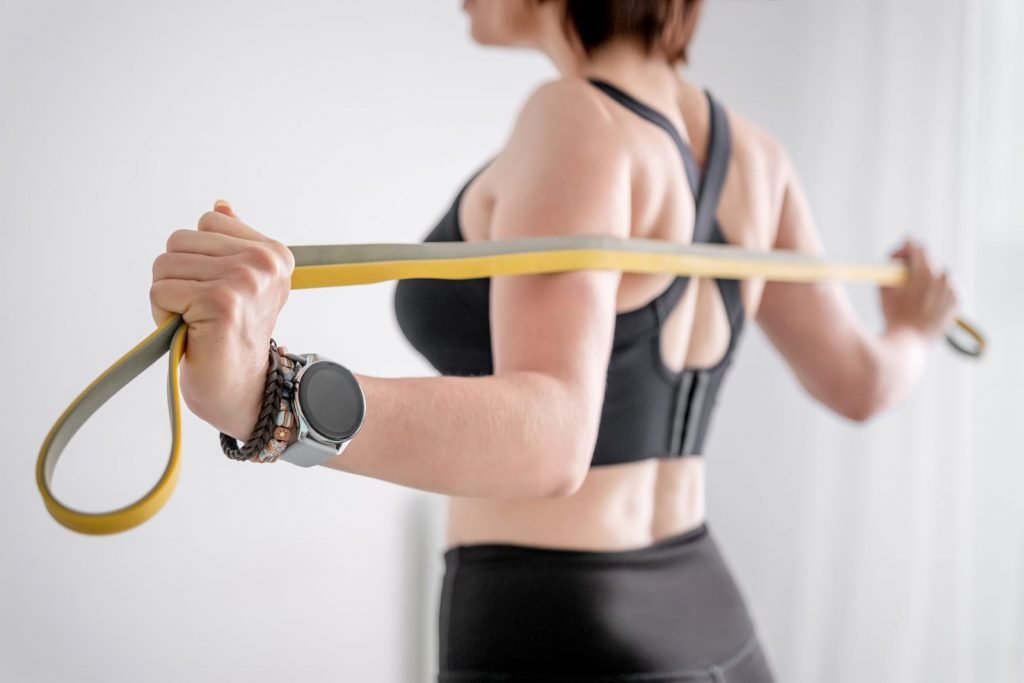
A Guide for Beginners on How to Use Resistance Bands or Exercise Bands for Workouts
Resistance bands are flexible, elastic bands used to strengthen muscles, enhance flexibility, and build endurance. Originally designed for rehabilitation exercises, these exercise bands have gained immense popularity in the fitness world due to their simplicity and effectiveness. Fitness enthusiasts and beginners alike use them to target various muscle groups without needing bulky pieces of equipment or weights.
Types of Resistance Bands
Resistance bands come in various types, each suited for different exercises and fitness goals. Understanding the options helps you choose the right band for your workout.
1. Loop Bands
Loop bands, also called power bands, are a single, continuous loop of latex or rubber bands. They range from light to extra heavy resistance, making them perfect for general strength training and mobility exercises. Use them for squats, lunges, or assisted pull-ups. The resistance levels allow for progression, enabling you to increase intensity as your strength improves.
2. Tube Bands
Tube bands are ideal for beginners. They come with handles, providing a better grip and more control during exercises. The handles make them easier to use, especially for movements that mimic traditional weightlifting exercises like chest presses, rows, and bicep curls. Tube bands offer a wide variety of resistance levels, which makes them suitable for any fitness level.
3. Mini Bands
Mini bands are smaller loops, typically placed around the ankles, knees, or thighs. They are excellent for targeting smaller muscle groups, such as the hips and glutes, during lateral movements and leg exercises. Mini bands help improve balance and stability while adding resistance to bodyweight exercises like clamshells, side steps, and glute bridges.
4. Therapy Bands
Therapy bands are flat, long, and usually non-looped. These bands can be used in rehabilitation settings for low-impact specific exercises. These bands provide gentle resistance, making them ideal for people recovering from injuries or looking to enhance flexibility and a full range of motion. Therapy bands also support stretchiness and basic mobility exercises, helping rebuild strength gradually.
5. Figure 8 Bands
Figure 8 bands have a unique design, resembling the number eight, with two loops and handles on each end. They are specifically designed for pull-apart exercises, targeting the upper back and shoulders. These bands are also useful for activating the hips and glutes when you place each leg through one loop.
Each type of resistance band offers unique benefits. Choosing the right one depends on your fitness level, workout goals, and personal preferences.
Read Also: Why Training Bands are A Must-Have Fitness Tool?
How to Choose Resistance Bands for Your Workout
Selecting the correct resistance band is key to achieving your fitness goals. Bands come in different levels of resistance: light, medium, and heavier resistance.

Here’s how to choose the right one:
Light Resistance Bands
Ideal for beginners or those starting rehabilitation exercises with a certified personal trainer. Use a resistance band for warm-ups, stretching, or exercises targeting smaller muscle groups like shoulders and arms. Light bands help improve flexibility and build basic strength without causing strain.
Medium Resistance Bands
Suitable for those who have some experience with resistance training. These bands offer moderate tension, perfect for general strength training, including squats, lunges, and upper body exercises like chest presses and rows. They provide a balance between challenge and control, allowing for gradual muscle building.
Heavy Resistance Bands
Best for experienced users aiming to build muscle mass and strength. Heavy bands add more tension, increasing the difficulty of exercises. Use them for compound movements like deadlifts, leg presses, or advanced upper-body workouts.
For Beginners
Start with a lighter band to master form and build foundational strength. As your confidence grows, gradually increase the resistance. This approach prevents injury and ensures steady progress.
Read Also: Tips for Incorporating Target Resitance Bands in Your Exercise
Safety Tips for Using Resistance Bands
Using resistance bands safely maximizes their benefits and minimizes the risk of injury. Keep these tips in mind:
- Avoid Common Mistakes: Don’t choose a band that’s too tight or too loose. An incorrect band tension can reduce the effectiveness of your workout and increase the risk of injury. Secure the band to an anchor point, like a door or pole, to prevent slips or snaps.
- Focus on Proper Technique: Proper form is essential to avoid strain and maximize muscle engagement. Use a mirror or record your workout to monitor your posture. Make sure your movements are controlled, not jerky or fast.
- Inspect Your Bands Regularly: Bands can wear out or develop tears over time. Check for signs of damage, such as small tears, thinning, or weak spots. Replace worn-out bands immediately to prevent accidents during exercise.
Beginner-Friendly Resistance Band Exercises
Resistance bands offer a simple way to build strength and improve fitness. Here are some beginner-friendly exercises that target different major muscle groups and provide a lightweight cardio or full-body workout.
Read Also: Innovative Ways to Enhance Your Workout with Exercise Bands
Full-Body Resistance Band Workout Routine
1. Opposition Jacks
Opposition Jacks focus on the chest and shoulders. Stand with your feet together and hold the band with both hands. Extend your arms out to the sides while pulling the band apart. Squeeze your shoulder blades together as you bring the band toward your chest. This exercise enhances upper body strength and stability.
2. Resisted Boxer
The Resisted Boxer works your biceps, triceps, and core. Anchor the band securely and stand facing away from it. Step on your right foot forward and mimic a punching motion with your arm, using the band for resistance. Switch sides to ensure balanced muscle development. This exercise boosts arm strength and improves core stability.
3. Resistance Band Deadlift
Resistance Band Deadlifts target the lower body, focusing on the hamstrings and glutes. Step on the band with feet hip-width apart, holding onto the other end in both hands. Bend your knees slightly, hinge at the hips, and lower your chest towards the floor. Keep your back straight and engage your core throughout the movement.
4. Band Rows
Band Rows help improve posture by strengthening the back muscles. Anchor the band to a sturdy object at waist height. Hold the ends in both hands, keeping your elbows close to your sides. Pull the band towards your torso, squeezing your shoulder blades together.
5. Biceps Curl and Squats
Biceps Curls build upper body strength by targeting the arms. Stand on the band and hold the ends with your palms facing up. Bend your elbows to bring your hands toward your shoulders, then lower them slowly.
For Squats, stand on the training band with feet shoulder-width apart, holding the handles at your shoulders. Lower into a squat position by bending your knees and pushing your hips back. Both exercises help in toning and strengthening the arms and legs.
Tips on Repetitions and Progression
- Start Slow: Begin with 10 repetitions per exercise.
- Increase Gradually: As your strength improves, add more repetitions or use a band with greater resistance.
- Focus on Form: Maintain proper form to prevent injury and maximize benefits. Use a mirror to check your posture and alignment.
These exercises provide a balanced workout that strengthens multiple muscle groups. Progress gradually by increasing resistance or reps to continue challenging your body and achieving better results.
Benefits of Resistance Band Training Plan
Resistance bands provide a versatile and effective way to improve your fitness, offering several benefits that extend beyond traditional workouts:

Improvement in Muscle Tone and Strength
Resistance bands help build and tone muscles by providing consistent tension throughout each exercise. They engage both large and small muscle groups, enhancing overall muscle tone and strength. Bands also improve posture by strengthening the back, shoulders, and core muscles, which support proper alignment.
Better Balance and Flexibility
Using gym bands promotes balance and coordination. Exercises like squats or lunges with bands force your body to stabilize itself, improving overall balance. They also enhance flexibility, stretching the muscles gently and increasing the range of motion without adding stress to the joints.
Increased Calorie Burn
Resistance band workouts engage multiple muscle groups simultaneously, which increases calorie burn. The continuous resistance provided by the bands challenges muscles throughout the entire range of motion, boosting metabolism and promoting fat loss.
Conclusion
Resistance band training offers an accessible and effective way to improve fitness, whether you are a beginner or an experienced athlete. Consistent use will lead to noticeable improvements in muscle tone, posture, balance, and overall fitness.
Explore the range of exercise bands available at Dynamo Fitness Equipment. Search for our collections of the finest gym equipment online or visit our megastores:
Gym Equipment Melbourne Stores
Gym Equipment Sydney Store
Gym Equipment Adelaide Store
Gym Equipment Perth Stores
Consult with our experts to find the perfect bands that match your fitness goals and start your fitness journey to a stronger, healthier you today!
